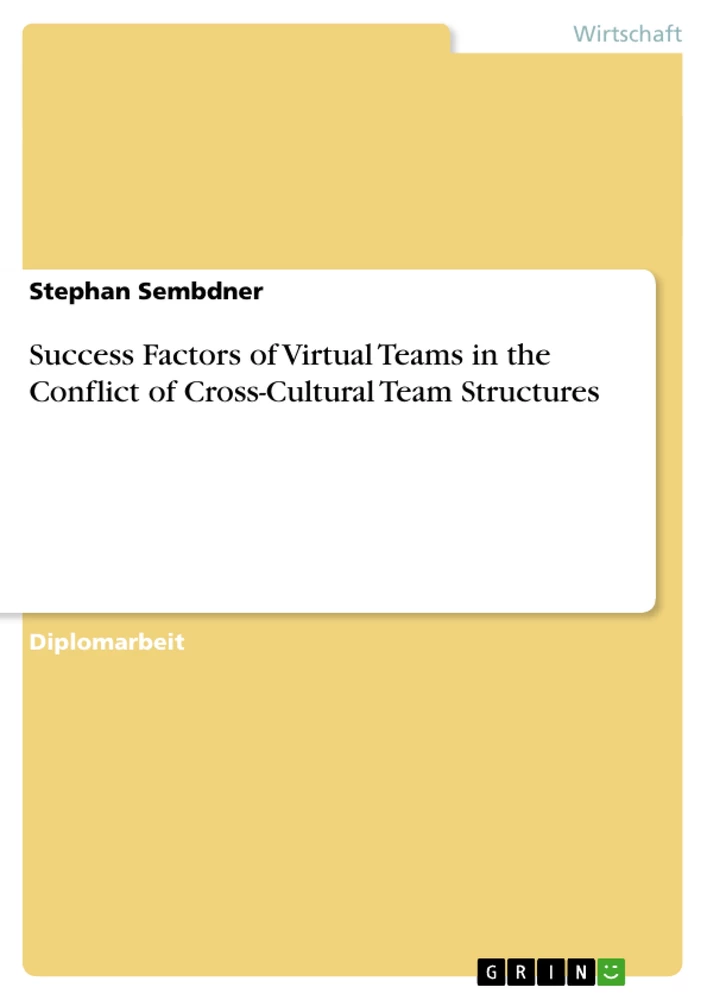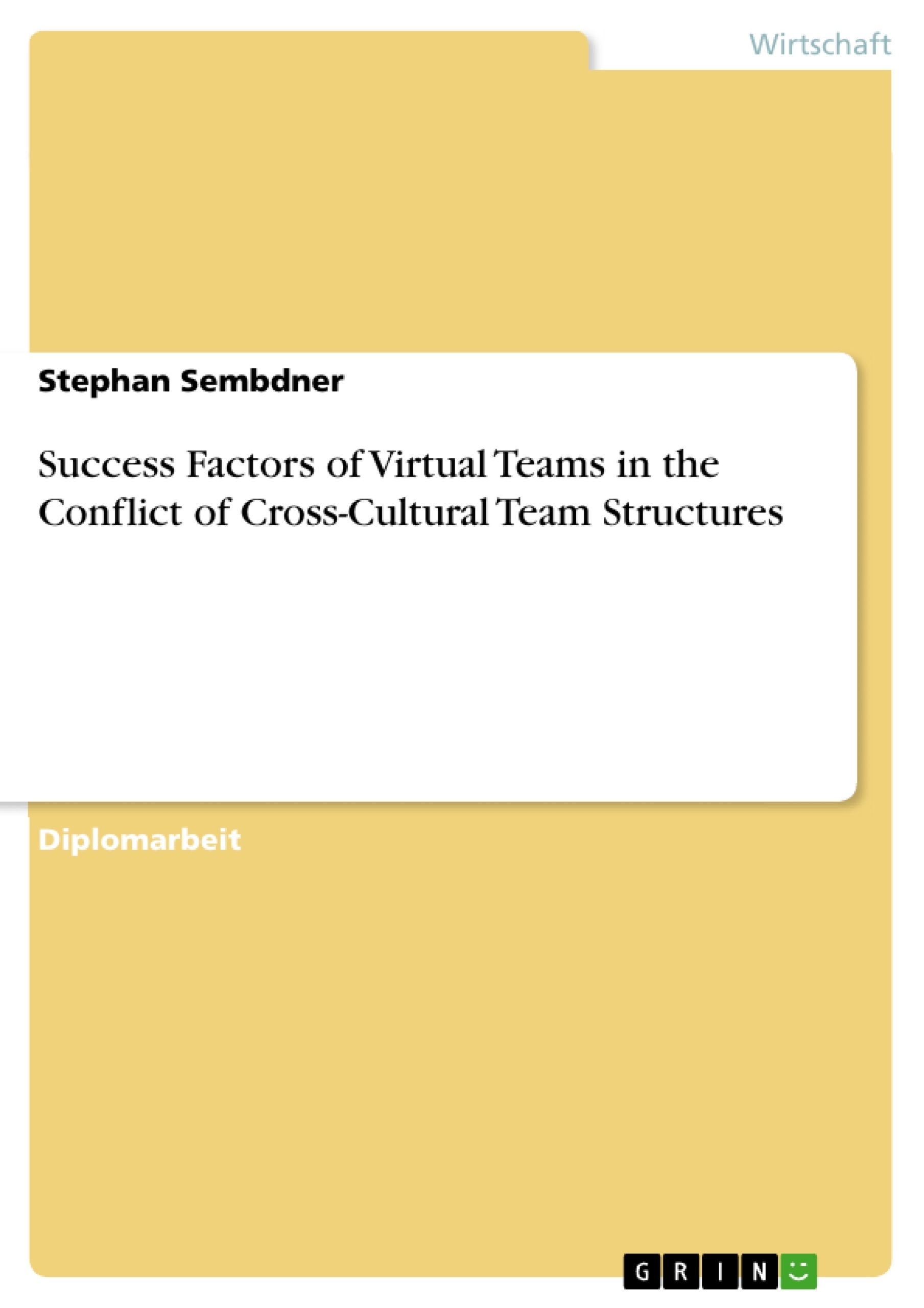Due to strong competition and to the most recent market requirements, more and more enterprises or organisations (in the following organisation only) have to rea-lign their business activities in a new way to cope with the current economic situation. Also in the respective organisational structures, specific changes have to be made to manufacture the products and to provide relevant services more effectively. Moreover, services are often provided increasingly no longer from a centralised location. For this reason, decentralised teams in various locations have developed, working together to jointly reach the targets. The services are either provided independently and on a full service basis, or such services are also provided in various parts and are then joined together or combined in other locations. So overall, organisations are facing new challenges to a growing extent. On the one hand, they have to cope with customers from different cultural areas, and on the other hand, the structure of the employees is changing simultaneously. Whether these organisations have international departments or not, the trend is now clearly towards heterogeneous team structures. Consequently, it is crucial for the organisations to be successful in spite of generally tougher market conditions. And this operational success will not come about automatically but will require well-functioning, efficient teams. As the author works in an international team with intercultural structures, there has been from the very start a particular interest in the findings and insights to be obtained in the framework of the work for this thesis.
Inhaltsverzeichnis
- 1 Introduction
- 1.1 Central issue and problem
- 1.2 Objective
- 1.3 Progress of research work and analyses
- 2 Group, work group and team
- 2.1 Historical review
- 2.2 Group
- 2.2.1 Definition
- 2.2.2 Significance
- 2.3 Work group
- 2.3.1 Definition
- 2.3.2 Significance
- 2.3.3 Group work vs. team work
- 2.4 Team
- 2.4.1 Definition
- 2.4.2 Significance
- 2.4.3 Work group vs. team
- 2.5 Virtual team
- 2.5.1 Definition: virtual
- 2.5.2 Definition: virtual team
- 2.5.3 Characteristics of a virtual team
- 2.5.3.1 Space distances
- 2.5.3.2 Time boundaries
- 2.5.3.3 Organisational boundaries
- 2.5.3.4 Communication technologies
- 2.5.4 Siginificance
- 2.5.5 Team vs. virtual team
- 3 Culture
- 3.1 Preliminary remark
- 3.2 Traditional concept of culture
- 3.2.1 Overview
- 3.2.2 Anthropological concept of culture
- 3.2.3 Iceberg model
- 3.2.4 Cultural elements
- 3.2.5 Cultural standards
- 3.2.5.1 Definition
- 3.2.5.2 Central cultural standards
- 3.2.5.3 The five-dimensions model based on Hofstede
- 3.2.5.3.1 Power distance
- 3.2.5.3.2 Uncertainty avoidance
- 3.2.5.3.3 Individualism vs. Collectivism
- 3.2.5.3.4 Masculinity vs. Femininity
- 3.2.5.3.5 Long- vs. Short-term orientation
- 3.3 Modern concept of culture
- 3.3.1 Multiculturalism
- 3.3.2 Concepts of multiculturalism
- 3.3.2.1 Interculturality
- 3.3.2.2 Multiculturality
- 3.3.2.3 Transculturality
- 4 Success factors
- 4.1 Preliminary remark
- 4.2 Models for team effectiveness / team performance
- 4.2.1 Performance based on Lersch
- 4.2.2 Effectiveness based on Hackman
- 4.2.3 Effectiveness based on Campion et al.
- 4.2.4 Summary
- 4.3 Influencing factors for success
- 4.3.1 Communication
- 4.3.1.1 Preliminary remark
- 4.3.1.2 Definition
- 4.3.1.3 Levels of communication
- 4.3.1.4 Communication media
- 4.3.1.5 Strategies of successful communication
- 4.3.1.6 Significance
- 4.3.2 Competence
- 4.3.2.1 Definition
- 4.3.2.2 Significance
- 4.3.3 Coordination
- 4.3.3.1 Definition
- 4.3.3.2 Significance
- 4.3.4 Motivation
- 4.3.4.1 Definition
- 4.3.4.2 Significance
- 4.3.5 Trust
- 4.3.5.1 Definition
- 4.3.5.2 Significance.
- 4.3.6 Conflicts
- 4.3.6.1 Definition
- 4.3.6.2 Significance
- 4.3.7 Rules
- 4.3.7.1 Definition
- 4.3.7.2 Significance
- 4.3.8 Team head vs. team member
- 4.3.8.1 Requirements on the team head
- 4.3.8.2 Requirements on the team member
- 4.3.1 Communication
- 4.4 Intercultural context
- 4.4.1 Intercultural communication
- 4.4.1.1 Definition
- 4.4.1.2 Intercultural communication problems
- 4.4.1.3 Significance
- 4.4.2 Intercultural competence
- 4.4.2.1 Definition
- 4.4.2.2 Intercultural competence models
- 4.4.2.3 Significance
- 4.4.3 Intercultural team structures
- 4.4.3.1 Definition
- 4.4.3.2 Significance
- 4.4.1 Intercultural communication
- 5 Research
- 5.1 Progress of research work and analyses
- 5.1.1 Problem-oriented interview
- 5.1.2 Interview guide and relevant categories
- 5.1.3 Selection of experts
- 5.1.4 Interviews
- 5.1.5 Transcription
- 5.1.6 Qualitative analysis of contents
- 5.2 Analyses of the interviews
- 5.2.1 Category 1: Communication
- 5.2.2 Category 2: Requirements on the team
- 5.2.3 Category 3: Intercultural competence
- 5.2.4 Category 4: Rules
- 5.2.5 Category 5: Motivation, trust or reliance
- 5.2.6 Category 6: Conflicts
- 5.2.7 Category 7: Benefits from virtual teams
- 5.3 General statements from the interviews.
- 5.4 Limits and weaknesses
- 5.1 Progress of research work and analyses
- 6 Summary and recommendation
Zielsetzung und Themenschwerpunkte
Die Bachelorarbeit befasst sich mit den Erfolgsfaktoren virtueller Teams im Kontext von interkulturellen Teamstrukturen. Der Fokus liegt dabei auf den Herausforderungen und Chancen, die die Zusammenarbeit in virtuellen Teams mit unterschiedlichen kulturellen Hintergründen mit sich bringt.
- Definition und Bedeutung von virtuellen Teams
- Einfluss von Kultur auf die Teamarbeit
- Identifizierung von Erfolgsfaktoren für virtuelle Teams
- Analyse von Herausforderungen im interkulturellen Kontext
- Entwicklung von Empfehlungen für die erfolgreiche Führung und Gestaltung virtueller Teams
Zusammenfassung der Kapitel
- Kapitel 1: Das Kapitel führt in die Thematik der Erfolgsfaktoren virtueller Teams im Konflikt von interkulturellen Teamstrukturen ein. Es wird das zentrale Problem und das Forschungsziel dargelegt, sowie der Aufbau der Arbeit beschrieben.
- Kapitel 2: Dieses Kapitel beleuchtet die Entwicklung und Definition von Gruppen, Arbeitsgruppen und Teams. Es wird insbesondere auf die Besonderheiten von virtuellen Teams eingegangen, wie beispielsweise die räumliche und zeitliche Distanz sowie die Kommunikation über digitale Medien.
- Kapitel 3: Der Einfluss von Kultur auf die Zusammenarbeit von Teams wird in diesem Kapitel behandelt. Es werden verschiedene Konzepte der Kultur vorgestellt, darunter das traditionelle und das moderne Kulturverständnis. Besondere Aufmerksamkeit wird dem Hofstede-Modell mit seinen fünf Dimensionen der Kultur gelegt.
- Kapitel 4: Dieses Kapitel widmet sich den Erfolgsfaktoren für Teams im Allgemeinen und virtuellen Teams im Besonderen. Es werden Modelle der Teameffektivität und der Teamperformance vorgestellt und verschiedene Einflussfaktoren für den Erfolg untersucht.
Schlüsselwörter
Virtuelle Teams, interkulturelle Teamstrukturen, Erfolgsfaktoren, Kommunikation, Kompetenz, Koordination, Motivation, Vertrauen, Konflikte, Regeln, Teamarbeit, Kultur, Kulturdimensionen, Hofstede-Modell, Interkulturelle Kompetenz, Interkulturelle Kommunikation.
- Citar trabajo
- Stephan Sembdner (Autor), 2010, Success Factors of Virtual Teams in the Conflict of Cross-Cultural Team Structures, Múnich, GRIN Verlag, https://www.grin.com/document/162308



